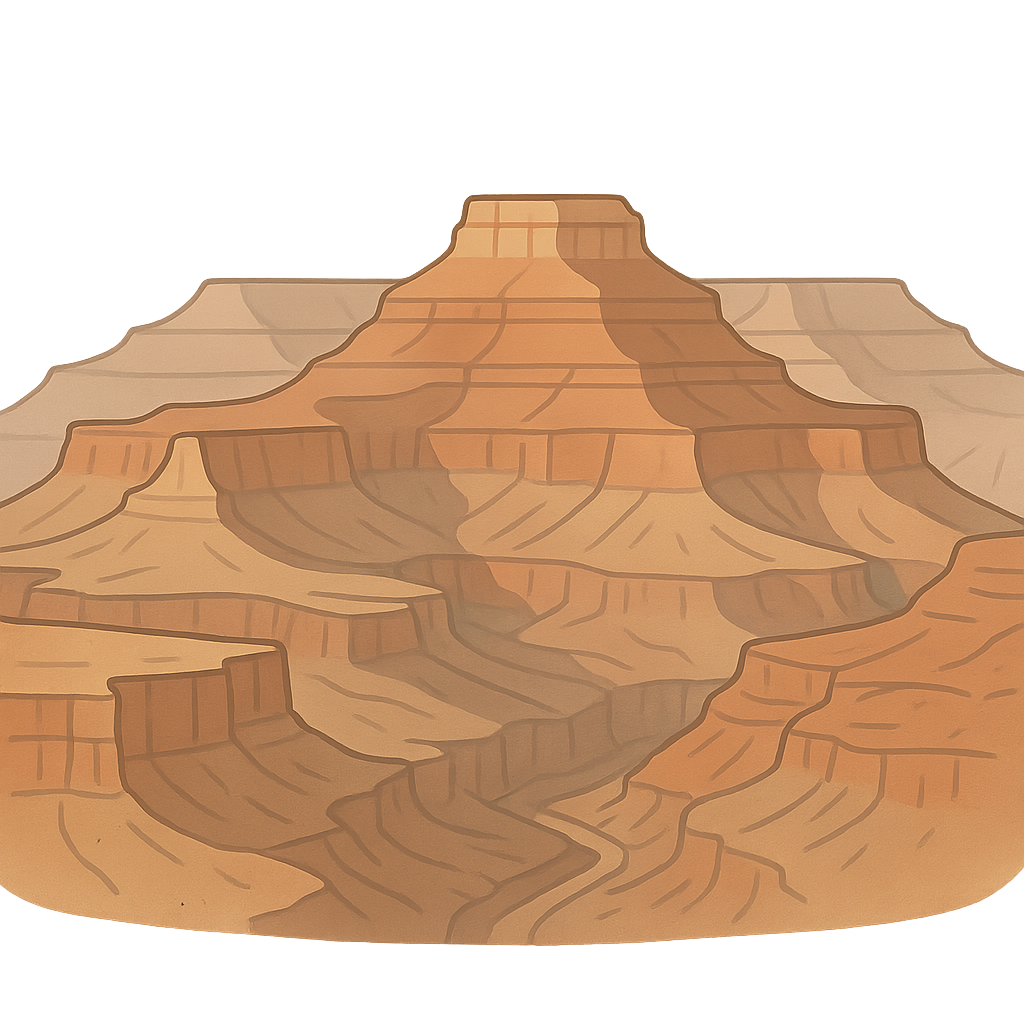The Canyon of Time
I am a great scar in the earth, a rainbow of rock that stretches farther than the eye can see. At sunrise, my cliffs blush with pink and gold; at sunset, they deepen into shades of violet and crimson. I am so vast that clouds drift below my rim, and the wind that sweeps through my corridors whispers tales that are billions of years old. To some, I am just a giant hole in the ground, but I am so much more. I am a library of time, an open book written in layers of stone, where every page tells a different story of our planet’s long and magnificent history. For millions of years, I have watched the sun and stars circle overhead, silently holding the secrets of ancient oceans, forgotten deserts, and towering mountains that came long before me. My story is not just about geology, but about the patience of water, the resilience of life, and the enduring spirit of discovery.
I am the Grand Canyon, and my story begins with a single, powerful artist: the Colorado River. For nearly six million years, this river has been my sculptor. It is a tireless artist, patiently carving, shaping, and deepening my walls, one grain of sand at a time. This process is called erosion, and it is the force that has exposed the chapters of Earth's history hidden within me. My oldest pages are at the very bottom, a dark, gleaming rock called the Vishnu Schist, which is almost two billion years old and tells of a time when tall mountains stood here. Higher up, you’ll find the Coconino Sandstone, which holds the fossilized tracks of creatures that walked across an ancient desert. Near my rim is the Kaibab Limestone, a creamy, white layer filled with the fossils of sponges and shellfish from a shallow sea that covered this land 270 million years ago. Each layer is a different world, a snapshot of a time long past, all revealed by the steady, persistent work of the river.
Long before explorers from other lands saw my colors, my canyons were a home. The first human footsteps echoed here nearly 4,000 years ago, left by people known as the Ancestral Puebloans. They built their homes into my cliff walls, farmed the land along my edges, and left behind pottery and mysterious drawings on my rock faces, clues to their lives and beliefs. Their spirits are still woven into my identity. Today, I am still the sacred, ancestral land of many Native American tribes, including the Havasupai, who live deep within my walls beside a turquoise creek, and the Hualapai and Navajo, whose reservations border my rims. To them, I am not just a natural wonder; I am a living being, a place of origin, healing, and spiritual connection. They have always understood my story and have treated me with a respect that comes from knowing every rock, plant, and spring has a purpose and a spirit.
For centuries, my existence was a story told only among the people who lived here. Then, in the year 1540, new eyes gazed upon me. A group of Spanish explorers led by García López de Cárdenas stood at my southern rim, sent to find legendary cities of gold. They were the first Europeans to see me, and they were stunned into silence by my immense scale. They tried for days to reach the Colorado River shimmering far below, but my steep, treacherous walls defeated them. For over 300 years after that, I remained largely a mystery to the outside world. That changed dramatically in 1869, when a brave, one-armed scientist and Civil War veteran named John Wesley Powell decided to conquer my secrets. He and his crew boarded small wooden boats and began a perilous, three-month journey down the wild and uncharted Colorado River. They battled furious rapids, lost boats and supplies, and faced starvation, but Powell meticulously mapped my twists and turns, studied my geology, and documented everything he saw. His daring expedition revealed my scientific treasures to the world and forever changed how people understood me.
John Wesley Powell’s journey sparked a new kind of interest in me. People began to travel from all over the world to witness my grandeur, and some realized that such a unique and ancient place needed to be protected. In 1903, President Theodore Roosevelt visited and was deeply moved. Standing on my rim, he declared that I was a treasure that belonged to every American and should be preserved for all time. He urged, “Leave it as it is. You cannot improve on it. The ages have been at work on it, and man can only mar it.” His powerful words helped protect me, and in 1919, I was officially named Grand Canyon National Park, a place to be kept safe forever. Today, millions of people visit me each year. They come to hike my trails, raft my river, and watch the changing light paint my walls. I continue to tell my story to anyone who will listen—a story of immense time, the power of nature, and the importance of preserving the wild, beautiful places of our world.
Reading Comprehension Questions
Click to see answer
